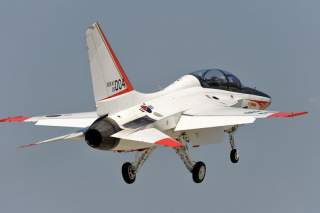FA-50 Golden Eagle: The Low-Cost Fighter that Might See Some Serious Combat
Many nations want it, but why does firebrand Philippine president Duterte hate it?
The Philippines has received four of its order of twelve FA-50s this year—despite discreet Chinese protests on the sale directed at Seoul. Manila has yet to acquire the Maverick and Sidewinder guided missiles the airplane requires to make full use of its capabilities. Originally, the Pacific nation intended to order another twelve in the next decade, but future orders are surely in doubt given Duterte’s statements, even if adherence to the current contract is not in question. The Philippine Golden Eagles have recently trained in tandem with American EA-18 Growlers. However, one recently lost its engine as a result of a bird strike.
Indonesia finished receiving 16 TA-50 jets in 2014 at $25 million apiece (once has since crashed). They are intended to serve in the light attack role as well as training.
Finally, Thailand will receive four T-50 trainers in 2018 to replace its old L-39 Albatrosses.
Other potential buyers that would impact the Asian security environment include Vietnam, Pakistan, Taiwan and Azerbaijan (still locked in a conflict with neighboring Armenia). Uzbekistan has already been denied a sale because of U.S. fears that American components in the system could be transferred to Russia. In South America, Colombia and Peru are seen as potential customers.
Even the United States is considering adopting a new T-50A variant with in-flight refueling capacity to replace its aging T-38 Talon jet trainers. With heavy backing from Lockheed-Martin, the Korean plane is currently competing with Raytheon/Aeromacchi’s M-346 and Boeing’s T-X trainer. The procurement, to be announced in 2017, would be for at least 350 new jet trainers.
So, Was Duterte Right?:
The Philippines’ new president is correct about one thing. The FA-50, at least in its present state, is not up to the task of taking on opposing fighters. It lacks the range necessary to operate far over the Pacific, and is not yet certified to launch medium-and long-range air-to-air missiles that are essential to modern aerial warfare.
However, this was not the intention behind acquiring the FA-50. The idea was to wean the Philippine Air Force back into operating jet fighters after having divested the last of its old F-5s in 2005—and in particular, aircraft using sophisticated avionics. It will take time to train pilots and ground crews to fly and maintain such aircraft. The idea, as spelled out by the plane’s advocates, is to use the FA-50 to bridge the gap to more-capable—and more difficult to fly and maintain—multi-role fighters acquired once the Philippine Air Force was ready for them.
And contrary to Duterte’s comments, the Golden Eagle does bring useful ground-attack and even anti-shipping ability through its ability to launch precision-guided munitions. If deployed on counter-insurgency missions, these would be an improvement over the dumb bombs the Philippine Air Force has used in the recent past.
Overall, the FA-50 is merely the first step in a long-term plan to modernize the Philippine Air Force and enable it to contest its home waters and airspace. It is a very expensive acquisition for the developing country—the order cost $427 million while the Philippines’s annual military budget in 2014 was $1.9 billion at the time. (The budget has increased over 50% since.)
Acquiring additional FA-50s and eventually more capable multi-role fighters would cost even more. A modernized Philippine Armed Forces could contribute to a Pacific defensive alliance—but would still be individually out-matched by China’s vastly larger military.
Duterte clearly thinks investing additional money in opposing the Chinese is a losing bet. For now, he wants détente with Beijing and would rather focus on waging his bloody war on drugs—and against Islamic insurgents—at home. This, of course, does not play into Washington’s containment strategy for the region, but the decision is Manila’s to make.
Time will tell whether Duterte will be more successful in keeping his cool while negotiating with China than he has been with Obama—and the extent to which he will refocus or reduce the Philippine military modernization project.
Regardless, the Golden Eagle will likely keeps it place in the Philippine Air Force, though whether it will lead into further investment towards a more capable air arm remains to be seen.
Sébastien Roblin holds a Master’s Degree in Conflict Resolution from Georgetown University and served as a university instructor for the Peace Corps in China. He has also worked in education, editing, and refugee resettlement in France and the United States. He currently writes on security and military history for War Is Boring.
Image: Advanced trainer T-50 Golden Eagle. Wikimedia Commons/Korea Aerospace Industries

